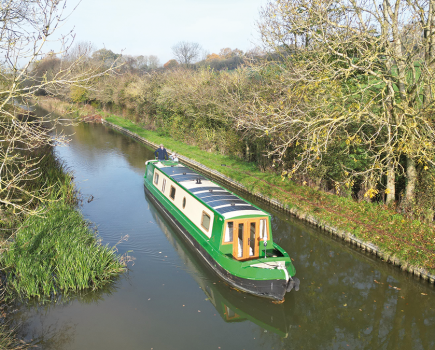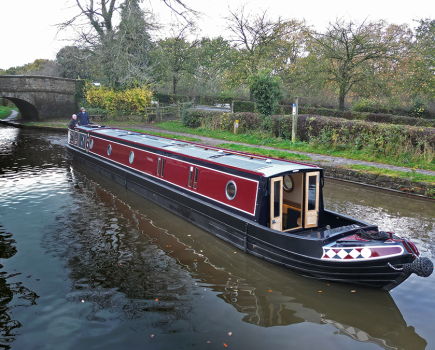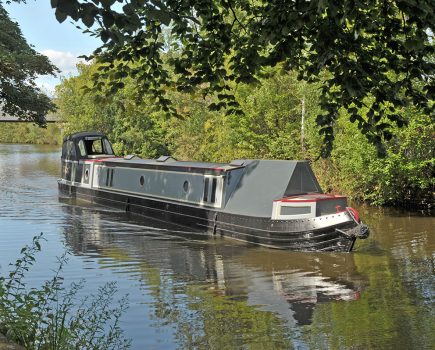Paul Simpson 58ft
Narrowboat building is still very much a cottage industry – a business populated by small companies more than likely started by craftsmen joiners taking their first small steps from the security of employment. Unfortunately woodworking skills don’t guarantee management ability and as a result there has always been a steady turnover of smaller boatbuilding companies. One such company that has just changed hands is Simpson’s Boats of Sharpness whose boat Mollie is the subject of this boat test. Paul Simpson has sold his company to a local businessman, though he will remain there doing joinery work for the firm and there are also some new personnel joining the business.Normally we would not test a boat in these circumstances, with the management and staff who built it no longer all in place. However Simpson’s Boats has always had a winning way with the boating public. Narrowboat Mollie was second Favourite at the Crick Show in 2006 and a previous boat was Show Favourite in 2004.It also builds boats of interesting and practical designs at affordable prices – the base price of Mollie is just under �70,000. If the new owners can continue to do so and resolve some of the criticisms we have, then the company will have a bright future.
DESIGN AND EXTERIOR
Mollie, like most Simpson boats, is what you might term a semi-bespoke craft. In other words, the firm has a ‘house style’ and a typical layout but can adapt this – or even start with a clean sheet of paper – as the customer wishes.Central to this house style is a very practical interior configuration which manages to incorporate a useful and versatile additional rear cabin as well as the familiar front saloon, centre galley, bedroom and bathroom into its 58 feet length.Mollie is built on a trad stern, Jonathan Wilson hull, using a familiar mix of three rectangular windows and two rear porthole windows each side together with a side hatch on the port side.The short front deck is open with no cratch and has bow lockers either side. Gas cylinders are stored in a front compartment and the 150 gallon water tank is under the floor.It’s a pretty looking boat, with a simple but bright paint scheme of red side panels with cream surrounds on a mid-blue base. It has to be said that we do have some criticisms of the exterior finish – the roof has several obvious ripples in it at the side welds and the detail painting could be tidier in places, with some of the surround lines looking as though they haven’t been properly masked.
SALOON
A pair of oak, half glazed doors leads down via a pair of steps into a very cottage style interior. The saloon is conventionally lined out in oak veneered ply set in solid oak frames but unlike many builders, Simpson’s then uses oak-veneered MDF rather than ply as the basis for much of its internal cabinetry work.It’s a cost-effective material and one that is widely used on land by the likes of kitchen makers because of its stability – it doesn’t shrink or warp – and because it can be easily cut into decorative shapes. The downside is that unless waterproofed versions are used it will deteriorate if exposed to water.Simpson’s Boats uses it to full effect with the wide use of curves and decorative detailing. For example spaced out along the junction of side and roof panels are a series of decoratively shaped elbows as just one of those touches.The saloon layout is simple, with a Morso Squirrel stove inside the front doors on the port side and a cupboard on the starboard, on which is a free-standing tv/dvd. A central heating radiator runs along the starboard side.There is no separate dinette on Mollie, with a fold-up table on the port side of the boat sufficing instead.You don’t need to be Sherlock Holmes to deduce that Mollie is a man’s boat – books on military history on the shelves, not much food in the fridge but a good stock of beer and champagne in the cupboards. And, when we visited, just one temporary chair in the saloon (a sofa was still on order) and functional sisal floor covering.In fact it is used as a weekdays floating bed-sit whilst its owner is working in nearby Gloucester so doesn’t need too much beyond the basics. However it is an airy, decent sized saloon and would easily accommodate a couple of comfortable arm chairs.Moving on towards the galley we find on the starboard side another familiar Simpson feature – a Welsh dresser with gracefully curved sides and arched top cupboard doors. The dresser also features a pull-out flap to convert it into a practical computer table or work-top.Opposite, the end of the port-side galley unit contains useful book shelving. An oak lined side hatch on this side ensures ample natural lighting in this area of the boat.
GALLEY
The open plan saloon leads on into a straightforward galley, with good storage space and amply provided with good natural lighting by two side windows and a large Houdini hatch.The galley cupboard units are set either side of the centre gangway. On the starboard side are three cupboards, again with those arched doors, together with a free-standing fridge whilst opposite, the single drainer stainless steel sink has a double cupboard under and a four drawer unit to the rear. Forwards of this is a four-burner gas hob and built-in Vanette oven and grill units. The melamine work surfaces are edged with oak as an elegant finishing touch.
CABIN
A handsome arched entrance – yet another Simpson trademark – leads through from the galley into the cabin. This two feet deep archway cleverly houses a full height wardrobe either side, with shelves and hanging rails offering plenty of storage room.Large windows make it a bright and airy space and the double bed, with its attractive, ornately styled headboard, nicely shaped bookshelf above and oak corner post, is a real feature. The bed itself pulls out to full double-width and two roll-out boxes provide plenty of storage underneath. Opposite the bed is a second central heating radiator.
BATHROOM
A door on the port side of the cabin leads into a very space-efficient walk through bathroom. A compact, half-sized bath with shower over sits along the starboard side and there is a pedestal basin inboard at its head end. Beyond the bath is a pump-out toilet unit. There is no central heating radiator in this room, just a conventional towel rail.The clever bathroom layout allows space for a floor level cupboard on the port side which has been designed to be large enough to house a washing machine if required. In Mollie, it is used as a simple storage cupboard. Above this is a smaller cupboard for toiletries. The central heating control unit and waste tank gauge are located on a face of this cupboard.
AFT CABIN
Leaving the bathroom, a central step leads up into the multi-purpose back cabin that is without doubt the cleverest aspect of Simpson’s boats. Twin 4ft 6in two-seater sofas sit either side of the centre line. They can be used with a fold-up table as a dinette area, as extra day cabin space so that passengers can be closer to the boat’s steerer or as sleeping berths for children. Under the benches is more useful stowage space.In the case of Mollie, this standard Simpson arrangement has been further modified with lift-out versions of the ornately fashioned rear side armrests and additional cushions over the side engine compartment covers. This provides either full-length single berths or the possibility of a full-sized cross-double with an infill panel.Porthole side windows ensure the necessary privacy in this area whilst a large Houdini hatch ensures good day-lighting.
TECHNICAL
Mollie is powered by a keel-cooled 1995cc Barrus Shire direct injection diesel engine with twin alternators allied to a PRM 150 hydraulic gearbox and delivering a substantial 45hp. Engine throttle controls, starter and instrument panel are located together on the starboard side entrance onto the stern area.Mollie’s owner also specified an Aquadrive vibration reduction system. The Aquadrive replaces the normal rigid coupling between gearbox and propeller shaft with a flexible and thrust-absorbing unit. This prevents engine vibration being transmitted through the shaft into the hull and also enables the engine mounts to work more efficiently at reducing vibration since they are not strained forwards by the propeller’s thrust.Access to the engine is slightly fiddly: first the tight fitting rear step must be fiddled out and then the central wooden floor panel lifted from between the rear side cushions. This exposes a series of loose-fitting cross battens, which can be lifted out to give free access to the unit.Removing the wooden floor under the starboard side cushion exposes the Mikuni central heating power unit while lifting the port side floor reveals the batteries.The weed hatch is accessed via a separate hinged steel cover on the rear deck – probably at the expense of the occasional nipped finger due to the absence of any substantial grip to help lift or lower the hefty lid.Overall, the installation is not the tidiest we have seen: the wooden frames and battens are completely unpainted softwood – they deserve a coat of primer even if only for cosmetic reasons. Some of the electrical wiring could be tidier as well.However our real concern was about the battery installation: the three leisure batteries and starter battery sit very close under the floor, leaving very little ventilation space around them, and the terminals are not protected by any covers. The potential dangers of such a shortcoming are highlighted by the fact that the cupboard door above them carries a clip holding a half dozen large spanners, one of which could all too easily by dropped onto an exposed terminal.The electrical systems installed on Mollie should be more than adequate to cope with its modest electrical fixtures and fittings and certainly allow for expansion of demand. An Electrolux Travel Power system generates 3.5kW of 240v AC output from the engine’s leisure side alternator when running and in conjunction with this is a Mastervolt charger, inverter and switching system.This comprises a battery charger, monitor unit, 2kW inverter and Masterswitch transfer switch which automatically switches AC input away from the inverter if either generator or shoreline inputs are activated.The component parts for these are installed in cupboards either side of the exit to the rear deck, with the Masterswitch and circuit trip switches in the starboard side cupboard where the header tanks for the engine are also located.A final technical point worth making about Mollie is that, like other Simpson boats, the insulation is provided by Kingspan polyurethane panels rather than the more often used spray-foam. It has a similar insulation value to the foam and is easier and tidier to apply but for full effectiveness must be cut carefully to fill all gaps (which it certainly was on another Simpson boat we saw under construction.)
ON THE WATER
The 45hp engine gives Mollie more than ample power as we were able to demonstrate on the wide waters of the Gloucester & Sharpness Canal.It’s worth remembering that power need not be equated simply with speed: it means the boat can slow quickly and be manoeuvred well and Mollie is certainly an easy craft to turn and responds well to the tiller at all times.The Aquadrive ensures minimal noise and vibration, though we would not have expected these to be a significant problem on a trad-layout boat with a properly insulated engine bay.
CONCLUSION
Even with some �10,000 of extras, Mollie comes in at just under �80,000 and that is a very good price these days for a bespoke craft.It is a very usable boat that performs well and demonstrates good space usage, with some pleasant, individualistic touches and particularly practical features like the aft cabin. The buying public like the concept, as evidenced by their reactions to it at recent Crick Shows.That said, we were a little disappointed with one or two aspects of this particular example of the company’s work: the detail painting could have been better as could the behind-the-scenes detailing finishing of woodwork and wiring.Interestingly, the day after testing Mollie we tried out the similarly priced Polish built Aqualine Manhattan whose test report we published last month. This factory-built boat offered a noticeably higher level of detail fit and finish to the Simpson boat – though of course the trade-off is that it can’t be tailored to the customer’s needs as a bespoke boat like Mollie can.All the same, life is not going to be easy for small builders like Simpson’s when faced with this sort of rigorous new competition.However if the new owners of the company can build on the very good customer relationships and public appeal that have been a strength of the business, continue to produce attractive, well thought-out craft – and give a little more attention to detail finishing then there is no reason why they should not be able to maintain and, indeed, further develop the business that Paul Simpson and his team created.
Length: 58 ft 0inBeam: 6ft 10in
Draught: 24inFuel tank: 45gal (200 l)Water tank: 150gal (680 l)Engine: Barrus Shire 45hpSteelwork: 10:6:4Electrical: 12v DC, 240v AC via 2kW Mastervolt & 3.5kW Travel Power Options fitted: Options fitted: Aquadrive, extra Houdini hatch, pump-out (not cassette) wc, Mastervolt system
Simpsons Boats
The Boat Shed
Brimscombe Port Ind Est.
Brimscombe
StroudGlos GL5 2QG
Tel: 01453 885850Price: �69,700 Price as tested �79,811www.simpsons.com







